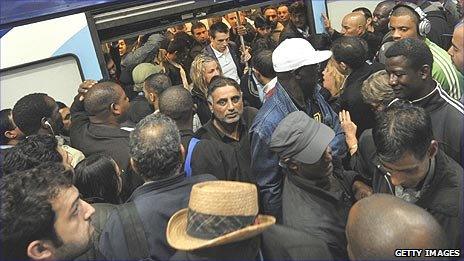Who, what, why: How to get off a busy train
- Published

Train overcrowding is unacceptable, and going to get worse, according to a report by MPs. But passengers often do themselves no favours by the way they crowd around doors when getting on and off.
Elbows at the ready and breathe in. You'll need to as a new report from MPs, external says overcrowding on trains in England and Wales will get substantially worse over the next four years, despite rises in ticket prices.
Plans to improve the situation will be unveiled soon, says the government. But could beleaguered passengers make the best of a bad lot by learning to get on and off trains more efficiently?
The following is an all too typical scene - a train stops, the doors slide open and anyone trying to get off is greeted by a wall of people. Alighting passengers must slowly funnel themselves through a small opening in the crowd.
For passengers trying to get on as quickly and easily as possible, this is exactly the wrong thing to do, says productivity consultant Eugene Chinal. Pushing gets you nowhere fast. It's all about creating - and maintaining - a steady flow, he says.
"The thing about efficiency is getting a consistent flow - if flow is impeded you get a build up. It's the same when driving on the motorway or trying to get into a football stadium."
Train companies realised this a long time ago, says Mr Chinal, who has worked with many transport companies on time and motion studies. Newer trains incorporate features to increase passenger flow.
Heavy doors that opened manually by turning a clunky handle have been replaced by electronic doors that open automatically, as soon as the train stops.
And speed is not always a solution, he adds. Too fast and people may stumble. Take it steady to keep things flowing.
"When it comes to flow, even the smallest action or impediment can have a snowballing effect, behind the person and in front of them," says Mr Chinal.
There is also a correct sequence to making embarking and disembarking as painless as possible. Firstly, all passengers who want to get off should be allowed to do so quickly - which means those eager to board the carriage ought to stand well back. Getting on as someone is getting off is a big no-no.
Once everyone is off new passengers should step on. It is very important that they continue moving down the carriage, this allows the flow to remain consistent. Stopping in the first clearing of free space slows everyone down, says Mr Chinal.
But getting on and off public transport efficiently is also very much about state of mind, not just the physical.
Queuing is like any other of society's rules. People observe a queue because they know what behaviour is expected of them to maintain order. Having the right attitude is as important to keeping things flowing as moving one's feet.
It's when people become more selfish that these systems start falling apart, says psychologist Dr Colin Gill. Yet if conditions are anything to go by, this is only going to get worse. The "already unacceptable levels of overcrowding will simply get worse and ever more intolerable", says the report from The Public Accounts Committee (PAC).
Such social rules are starting to breakdown throughout British society, adds Dr Gill.
"We are becoming a society of individualists, rather than a society. In modern culture people don't get rewarded for doing the right thing and there aren't so many sanctions for doing something wrong. There are fewer moral absolutes."
We are also driven by a "herd instinct". People don't want to be on the outside because they feel vulnerable, says Dr Gill. It's why we push to be in the centre.